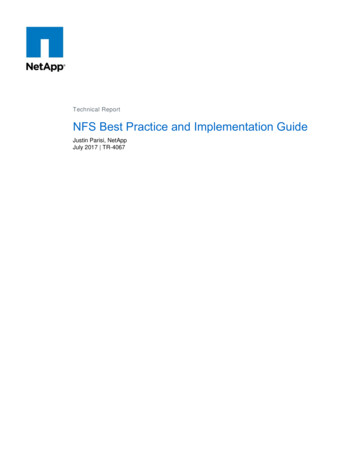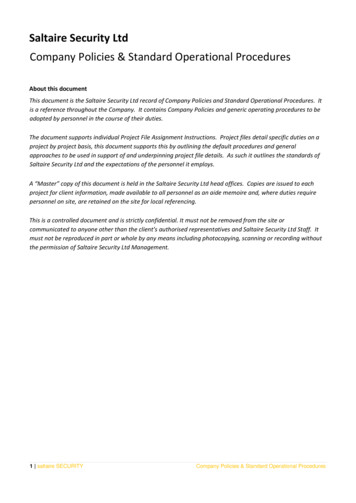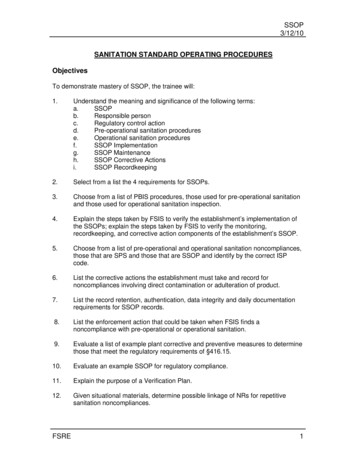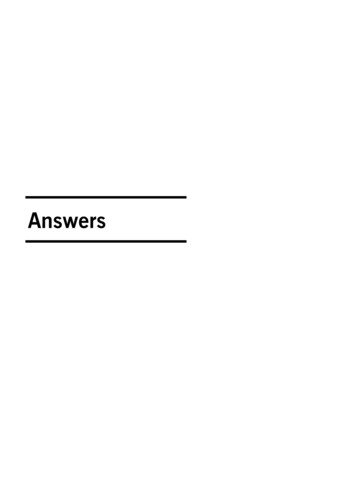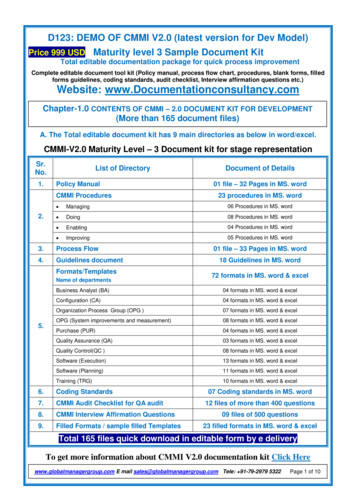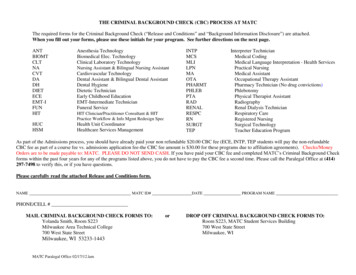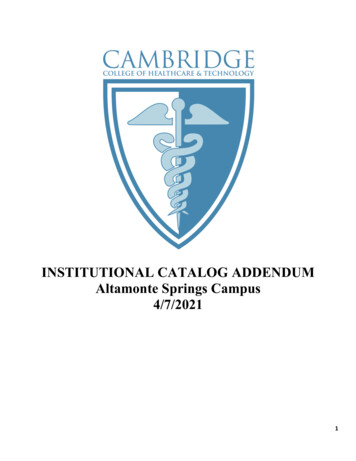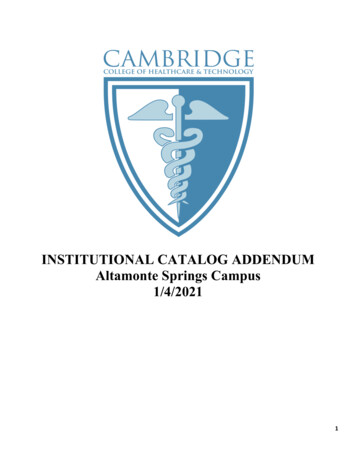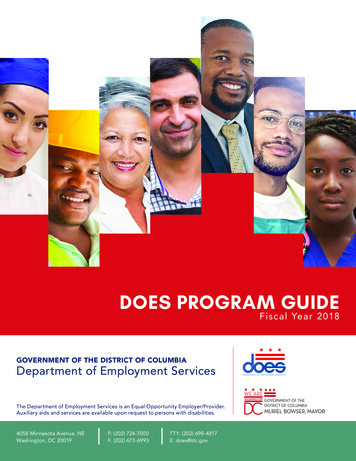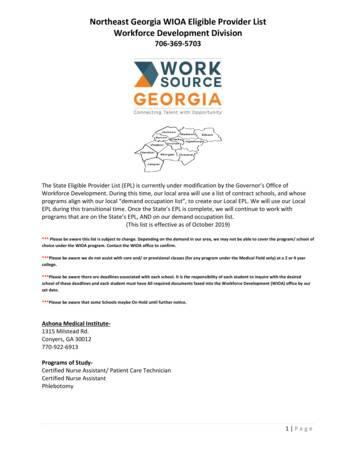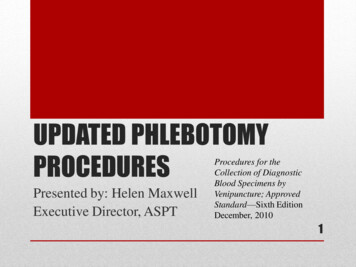
Transcription
UPDATED PHLEBOTOMYPROCEDURESPresented by: Helen MaxwellExecutive Director, ASPTProcedures for theCollection of DiagnosticBlood Specimens byVenipuncture; ApprovedStandard—Sixth EditionDecember, 20101
CLSI 2011 STANDARDSClinical Laboratory Standards Institute2
Formally NCCLS International, interdisciplinary, non-profit,standards-developing, educationalorganization World-wide standards Way to improve patient testing andhealthcare servicesWhat is CLSI?3
UNIVERSAL PRECAUTIONSApply to transmission of blood bornepathogens.4
STANDARD PRECAUTIONSCover transmission of all knowninfection agents; more comprehensive.5
Standard Precautions Combine UniversalPrecautionsCLSI Standards Body SubstanceIsolation Practices6
Personal Protection in the Laboratory: Wear long-sleeved gowns with closed fronts orlong-sleeved laboratory coats that are buttonedclosed while in the laboratory. Wear laboratory coats or gowns inside thelaboratory only. Reusable cloth or disposable gowns/coats may beused.PROTECTIVE CLOTHING7
Occlusive Dressing Cover all non-intact skin located on parts of thebody exposed to blood or body fluid with a waterimpermeable occlusive bandage. NOTE:REMOVE ALL PERSONAL PROTECTIVEEQUIPMENT BEFORE LEAVING THE LABORATORYOR WORK AREA.PROTECTIVE CLOTHING8
Gloves of proper size and material must beprovided for your protection. Use aseptic techniques when both putting on andremoving gloves. Wear gloves at specimen receiving and set-upareas. Do not contaminate clean areas by contact withcontaminated gloves. Change gloves after contact with each patient. Removes gloves before handling telephones,uncontaminated laboratory equipment, doorknobs,etc.HAND PROTECTION7.3, Gloves9
Decontaminate hands after touching all potentiallyinfectious material, whether or not gloves are worn. Use an alcohol-based hand rub or soap and waterif hands are not visibly soiled. Removes gloves promptly after the completion of alltasks.HAND HYGIENE10
Decontaminate hands immediately after gloves areremoved and when otherwise indicated to avoidtransfer of microorganisms to other surfaces andenvironments. Change gloves between patients when performingphlebotomy. Decontaminate the hands after gloveremoval and before donning new gloves.HAND HYGIENE11
Decontaminate hands: After the completion of work and before leavingthe laboratory: Before eating, drinking, smoking, applying makeup, changing contact lenses, and before and afterusing lavatory facilities; and Before all other activities which entail handcontact with mucous membranes, eyes, or breaksin the skinHAND HYGIENE12
Avoid soap products that may disrupt skin integrity.A moisturizing hand cream may reduce skin irritationcaused by frequent hand washing; but somenonpetroleum-based hand creams may affect gloveintegrity. Avoid wearing artificial fingernails or extenderswhen in direct contact with patients at high risk forinfections, such as those in intensive care units oroperating rooms.HAND HYGIENE13
Use facial barrier protection if there is a reasonablyanticipated potential for spattering or splashing bloodor body substances. Full-face shields made of lightweight transparentplastic are the preferred means of facial protection. Splashguards may serve as an acceptable alternativeto plastic face shields.FACIAL PROTECTION14
Use a fluid-resistant mask and eye protection if faceshields are not available. Ordinary prescription glasses are not adequate eyeprotection. Use plastic, wraparound safety glassesthat fit over regular glasses.FACIAL PROTECTION15
All respirators used in healthcare settings in theUnited States must be certified and approved byNIOSH. In the United States, OSHA requires that respiratorsbe used as part of a respiratory protection plan thatincludes medical evaluations, fit-testing, properselection of respirators, annual training, andrespirator maintenance.RESPIRATORY PROTECTION16
STEPS IN DOING AVENIPUNCTUREFollowing the steps in doing a propervenipuncture is critical in healthcare.17
WHAT IS THE MOSTIMPORTANT STEP INDRAWING BLOOD?STEPS IN DOING AVENIPUNCTURE18
Identifying the In-Patient Must be two (2) identifiers: Ask the patient’s FULL name Ask the patient’s date of birthSTEPS IN DOING AVENIPUNCTURE8.2.119
Identifying the Out-Patient Must be at least two (2) identifiers: Ask the patient’s FULL name Ask the patient’s date of birth Ask the patient’s addressSTEPS IN DOING AVENIPUNCTURE20
NEVER DRAW IF THEREIS A DISCREPANCY!STEPS IN DOING AVENIPUNCTURE21
Identify yourself: Who you are Where you are from What you are going to doSTEPS IN DOING AVENIPUNCTURE22
VERIFY fasting states: Have you had anything to eat or drink? When was the last time you had anything to eator drink?STEPS IN DOING AVENIPUNCTURE23
Verify Diet Restrictions Some tests require diet restrictions Fasting Eliminating certain foods**Each facility should have a policy manualSTEPS IN DOING AVENIPUNCTURE24
Check Latex Sensitivity: Gloves Tourniquets Bandages Check for Allergies: Seafood OtherSTEPS IN DOING AVENIPUNCTURE8.225
Sanitize hands Put gloves on Recommended:DO NOT touch patient without gloves on.STEPS IN DOING AVENIPUNCTURE8.226
Check Request Form Should Include: Patient’s: Full name Date of birth Identification number Date, time it is drawn Name or initial of HCP Department/tube colorSTEPS IN DOING AVENIPUNCTURE8.1.127
Position the Patient Make them comfortable Foreign objects out of mouth Gum Mints Food ThermometerSTEPS IN DOING AVENIPUNCTURE8.528
Assemble Supplies Inspect all supplies Remember to use the same (manufacturer)needle, holder, and tube Inspect all tubesSTEPS IN DOING AVENIPUNCTURE8.429
CLSI states—NEVER combine: Tubes Holders Needles From different manufacturesSTEPS IN DOING AVENIPUNCTURE8.4.4.130
Could cause: Hemolysis Needle/holder disengagement Inadequate filling of a tubeSTEPS IN DOING AVENIPUNCTURE31
TUBES: Check for expiration dates. Must have a clear view of the contents unlesstest must be shielded from light. No sharp edges No surface roughness (capable of cutting skin) Should be used to collect blood straight intothe tube Must retain vacuumSTEPS IN DOING AVENIPUNCTURE8.9.332
Glass tubes are strongly recommended formedication levels. Plastic/glass serum should never be usedbefore a coagulation tube.STEPS IN DOING AVENIPUNCTURE8.1033
Tubes MUST be: Durable over its shelf life and duringcentrifugation. Plastic syringes should be avoided.STEPS IN DOING AVENIPUNCTURE34
Apply tourniquet Tourniquet is used to increase intravascularpressure (*Tourniquet should be latex-free; single use only.) Helps with the palpitation of veinHelps with filling of the tubeWithin 20 seconds, the analytes begin to changeSuggested time 1 minuteRetying a tourniquet: must wait two (2) minutesSTEPS IN DOING AVENIPUNCTURE7.735
Tourniquet Location 2-4 inches above OR 3 fingersSTEPS IN DOING AVENIPUNCTURE36
DO NOT HAVEPATIENT PUMP HAND!STEPS IN DOING AVENIPUNCTURE8.6.437
Blood Pressure Cuff: Inflate no more than 40 mmHg Pump hand one to two times NO vigorous hand pumping(change certain analytes)STEPS IN DOING AVENIPUNCTURE8.6.338
DO NOT USE the following veins!!! Underside wristLower extremitiesFeetAnklesOn the side of a mastectomy armSTEPS IN DOING AVENIPUNCTURE8.6.539
Problems that can occur: PhlebitisThrombophlebitisTissue Necrosis (death of tissue and cells)Accidental Arterial PunctureNerve DamageSTEPS IN DOING AVENIPUNCTURE40
Select SiteDiagram: Clinical and Laboratory Standards InstituteSTEPS IN DOING AVENIPUNCTURE8.6.641
Cleanse Venipuncture Site Concentric motion from center to peripheral Allow area to DRY at least 30 seconds Do not wipe dry Prevents: Hemolysis Prevent burn in sensation on patient Allow antiseptic to workSTEPS IN DOING AVENIPUNCTURE8.842
Difficult VeinsIf you MUST re-touch, then youMUST re-CLEAN!STEPS IN DOING AVENIPUNCTURE8.8.343
Perform the Venipuncture Hold arm below the venipuncture site.**NO “window” method! Puncture at a 30 degree angle. Use correct order of draw. See the ORDER OF DRAWNEXT SLIDESTEPS IN DOING AVENIPUNCTURE8.9.144
YELLOWLT. BLUEPLAIN REDPLASTIC REDGOLD, RED/GRAYGREENLAVENDER, TALL PINKPURPLE GRAYSPS (Blood Cultures)Sodium CitrateNo AdditiveClot ActivatorSST/Gel w/ Clot ActivatorHeparin-Lithium or SodiumEDTAEDTASodium Fluoride, Potassium Oxalate NOTE:Other tubes will be added into the Order of Draw by their additives.CLSIORDER OF DRAW8.1645
Invert tubes IMMEDIATELY: CA 5 timesNa Citrate 3-4 timesHeparin 8 timesEDTA 8 timesNa Fluoride 8 timesSTEPS IN DOING AVENIPUNCTURE46
Perform the Venipuncture Release tourniquet. Place gauze over the site. (NO cotton balls!) Gauze should be pre-packaged; 2X2. Remove needle and dispose IMMEDIATELY.STEPS IN DOING AVENIPUNCTURE7.947
NOTE: A clearing tube must be used if using abutterfly for coagulation studies A non-additive tube may be drawn beforecoagulation studies when using a multi-drawneedle NO clot activator or additive tube should bedrawn before coagulation studiesSTEPS IN DOING AVENIPUNCTURE8.10.148
If patient has a problem, do not useammonia inhalants. Patients may have an adverse reaction.STEPS IN DOING AVENIPUNCTURE8.1349
Check the venipuncture site (after 3-5 minutes). Bandage for 15 minutes to one (1) hour. Patients should NOT bend the arm up. Healthcare professional should notify nurse or supervisorif bleeding lasts more than five (5) minutes.STEPS IN DOING AVENIPUNCTURE8.14.350
Labeling: Patient’s last and first name.ID #Date, time, and initials of person collecting sample.Time when TDMs are being collected.STEPS IN DOING AVENIPUNCTURE8.1551
NEVER leave a patient beforelabeling tubes!NEVER walk into a lab without aspecimen being labeled!STEPS IN DOING AVENIPUNCTURE52
Examples of tests requiring specimenchilling are: GastrinAmmoniaLactic acidCatecholaminesPyruvateParathyroid hormone (PTH)SPECIAL HANDLING8.1653
Examples of tests requiring specimentransportation at 37 C include: Cold agglutinin Cryofibrinogen CryoglobulinsSPECIAL HANDLING8.1654
Examples of tests requiring specimenprotection from light: BilirubinAll Vitamin levelsBeta CarotenePorphyrinsSPECIAL HANDLING8.1655
Send Blood Collection Tubes to the ProperLaboratories: Appropriately labeled blood collection tubesshould be sent to laboratories designated toperform the required testing procedures.Maintain proper transport conditions topreserve specimen integrity.STEPS IN DOING AVENIPUNCTURE8.1756
Serum: Specimens should be clotted before centrifugation. Spontaneous and complete clotting normally occurs within30 to 60 minutes at room temperature (20 to 25 C). NOTE: The use of a wooden applicator stick or similardevice for the release of a clot attached to the tube closureor the sides of the tube (i.e., “rimming”) is notrecommended because it is a potential source for thelaboratory-induced hemolysis. The time to clot will be prolonged if the patient is onanticoagulant therapy or if the specimen is chilled.SPECIMEN HANDLING57
Plasma: Use a collection device containing ananticoagulant when plasma is required oracceptable. Centrifuge anti-coagulated specimensimmediately after collection.SPECIMEN HANDLING58
Chilled Specimens: To chill a specimen, place it immediately in amixture of ice and water. Good contact betweenthe cooling medium and the specimen is essential. Adequate cooling is essential; however, avoiddirect contact between the specimen and ice (orother cooling materials such as dry ice), becausethe temperature extreme may cause hemolysis. NOTE: Chilling whole blood beyond two hoursis contraindicated for a specimen intended forpotassium.SPECIMEN HANDLING59
Preservatives: Use sodium fluoride to stabilize glucose in thepresence of blood cells for up to 24 hours at25 C or 48 hours at 4 to 8 C. Use micro collection devices containing asuitable anti-glycolytic agent for pediatric bloodglucose collection.SPECIMEN HANDLING60
Criteria for Rejection: Under the following conditions, blood specimensmay not be acceptable for testing purposes: Inappropriate specimen containers Inadequate or incorrect specimen identification Inappropriate volume of blood Using the wrong collection tube Hemolysis Improper storage/transportationSPECIMEN HANDLING61
Time and Temperature: Transport specimens in the appropriatebiohazard bags or containers to the laboratoryin as short a time as possible. Unless chilling of the specimen is required(i.e., lactic acid, ammonia), transport allspecimens at room temperature. Prompt removal of specimens from thecollections area is especially important if thearea temperature is above 22 C, which maycause some measurands to deteriorate.SPECIMEN TRANSPORT62
Tube Orientation: Place tubes of blood in a vertical position. Non-anti-coagulated tubes that contain gelshould always be stored in an upright positionas soon as the mixing is completed. NOTE: Evaluate automated transport systems,pneumatic or otherwise, for any effects onlaboratory results.SPECIMEN TRANSPORT63
Tube Closure: Keep tubes of blood closed at all times.Keeping the tube in a closed positioneliminated possible exogenous contaminationof the specimen and prevents evaporation andthe possibility of spills and aerosols.SPECIMEN TRANSPORT64
Agitation: Gentle handling of collected specimens helpsto minimize erythrocyte damage leading tohemolysis of specimens.SPECIMEN TRANSPORT65
Exposure to Light: Avoid exposing blood specimens forphotosensitive measurands (i.e., bilirubin) toartificial light or sunlight (ultraviolet) for anylength of time. Protect these specimens with an aluminum foilwrap, an amber specimen container, or theequivalent.SPECIMEN TRANSPORT66
Please feel free to contact ASPT withany further questions.Thank you for your time c.comQUESTIONS67
CLSI ORDER OF DRAW YELLOW SPS (Blood Cultures) LT.BLUE Sodium Citrate PLAIN RED No Additive PLASTIC RED Clot Activator GOLD, RED/GRAY SST/Gel w/ Clot Activator GREEN Heparin-Lithium or Sodium LAVENDER, TALL PINK EDTA PURPLE EDTA GRAY Sodium Fluoride, Potassium Oxalate
